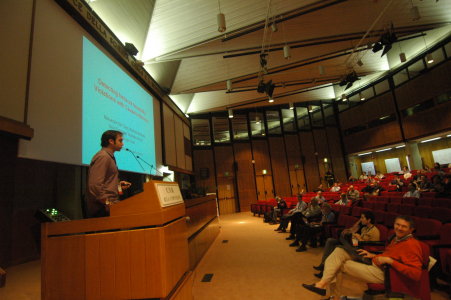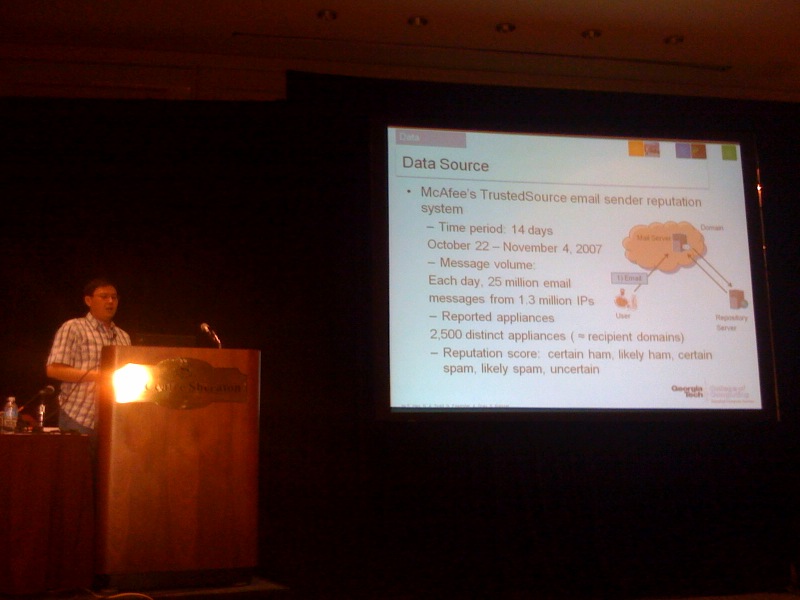
For more information about how Collage works, please see the full paper. For more information, and to contribute to or download the code, please see the Collage project home page.
You can also read about Collage in various trade articles:
Colalge also appeared on Slashdot twice; Professor Feamster also recently blogged about Collage, here.
]]>The Transit Portal allows each service hosted in a cloud to perform its own Internet routing. For more information on Transit Portal, see the full paper, or check out the following articles:
Professor Nick Feamster also blogged about the Transit Portal here. Lots of information about Transit Portal, including information about how to install a Transit Portal yourself, is available on the GENI project wiki for Transit Portal.
]]>
Joon and Ankur have been developing a next-generation version of Georgia Tech's access control framework, based on OpenFlow. The OpenFlow architecture decouples a network's control framework from individual network devices. We are using this framework to allow operators to express more complex policies in a higher-level language. The Resonance access control system is deployed on the Georgia Tech campus in research labs across three buildings. We are in the process of evaluating this deployment for real users on the network. A more widespread campus deployment is planned over the course of the coming year.
The video below shows the Resonance system in action. You can also read a bit more about Resonance:
- In our ACM SIGCOMM workshop paper from last year, which describes the basic design.
- In our IEEE LANMAN invited paper, which describes some of the high-level design philosophy behind Resonance.
]]>
NANO detects whether a user's access ISP is discriminating against certain users, destinations or applications. In contrast to existing tools, NANO relies primarily on data that is passively collected from user's machines. To use NANO, simply download and install the NANO-Agent on your machine. Currently, NANO-Agent runs only on Linux, but a Windows version will be coming shortly.
NANO is part of Google's Measurement Lab project.
For more information about NANO, please see the following:

In Deloitte's recent Global Security Survey, nearly half of the companies surveyed reported some internal security breach; of those, about a third of breaches resulted from viruses or malware, and another third resulted from insider fraud. The Pedigree project aims to develop mechanisms to control and prevent these data breaches in enterprise networks. This growing problem begs the need for better techniques for controlling information flow in the network itself.
We are addressing several research challenges. First, we are exploring the appropriate granularity for tainting that preserves semantics without imposing unacceptable memory and performance overhead. Second, we are designing the system to minimize performance overhead on applications. Third, we are exploring translation mechanisms between host-based taints and network-based taints, so that taints carried in network traffic convey meaningful semantics without imposing prohibitive network overhead. The research will result in an information tracking and control system that is deployed in experimental settings (e.g., the Georgia Tech campus network) using the existing and forthcoming programmable switch implementations.
Our writeup of the system remonstration from SIGCOMM 2009 provides more details. Details on the aware are available at the NSF Web site.
]]>
The OpenFlow Click element is a module for the Click modular router that can be controlled via a standard OpenFlow controller. The element essentially turns a Click router into a software switch with flow table entries. One of the most powerful aspects of this paradigm is that it allows hybrid packet and flow processing, as part of a paradigm we call Flowlets.
More details about OpenFlow Click element are available here:


- Transit Portal: Bringing Connectivity to the Cloud. Student: Valas Valancius
- Securing Enterprise Networks with Traffic Tainting. Students: Anirudh Ramachandran, Yogesh Mundada, Mukarram bin Tariq
- Network and End-System Support for Transparent Use of Multiple Paths. Student: Murtaza Motiwala.
Below is a photo of Yogesh Mundada giving the demo of our Pedigree system, which performs network-level enforcement of information-flow policies in an enterprise network.

For more information about our GENI-funded project, please see our project web page at geni.net.
Here's a video summarizing Valas's demo:
]]>